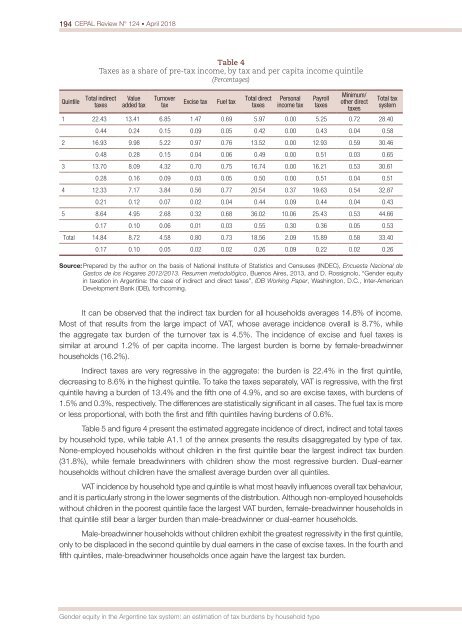CEPAL Review no. 124
April 2018
April 2018
Create successful ePaper yourself
Turn your PDF publications into a flip-book with our unique Google optimized e-Paper software.
194 <strong>CEPAL</strong> <strong>Review</strong> N° <strong>124</strong> • April 2018<br />
Quintile<br />
Table 4<br />
Taxes as a share of pre-tax income, by tax and per capita income quintile<br />
(Percentages)<br />
Total indirect<br />
taxes<br />
Value<br />
added tax<br />
Tur<strong>no</strong>ver<br />
tax<br />
Excise tax<br />
Fuel tax<br />
Total direct<br />
taxes<br />
Personal<br />
income tax<br />
Payroll<br />
taxes<br />
Minimum/<br />
other direct<br />
taxes<br />
1 22.43 13.41 6.85 1.47 0.69 5.97 0.00 5.25 0.72 28.40<br />
Total tax<br />
system<br />
0.44 0.24 0.15 0.09 0.05 0.42 0.00 0.43 0.04 0.58<br />
2 16.93 9.98 5.22 0.97 0.76 13.52 0.00 12.93 0.59 30.46<br />
0.48 0.28 0.15 0.04 0.06 0.49 0.00 0.51 0.03 0.65<br />
3 13.70 8.09 4.32 0.70 0.75 16.74 0.00 16.21 0.53 30.61<br />
0.28 0.16 0.09 0.03 0.05 0.50 0.00 0.51 0.04 0.51<br />
4 12.33 7.17 3.84 0.56 0.77 20.54 0.37 19.63 0.54 32.87<br />
0.21 0.12 0.07 0.02 0.04 0.44 0.09 0.44 0.04 0.43<br />
5 8.64 4.95 2.68 0.32 0.68 36.02 10.06 25.43 0.53 44.66<br />
0.17 0.10 0.06 0.01 0.03 0.55 0.30 0.36 0.05 0.53<br />
Total 14.84 8.72 4.58 0.80 0.73 18.56 2.09 15.89 0.58 33.40<br />
0.17 0.10 0.05 0.02 0.02 0.26 0.09 0.22 0.02 0.26<br />
Source: Prepared by the author on the basis of National Institute of Statistics and Censuses (INDEC), Encuesta Nacional de<br />
Gastos de los Hogares 2012/2013. Resumen metodológico, Bue<strong>no</strong>s Aires, 2013, and D. Rossig<strong>no</strong>lo, “Gender equity<br />
in taxation in Argentina: the case of indirect and direct taxes”, IDB Working Paper, Washington, D.C., Inter-American<br />
Development Bank (IDB), forthcoming.<br />
It can be observed that the indirect tax burden for all households averages 14.8% of income.<br />
Most of that results from the large impact of VAT, whose average incidence overall is 8.7%, while<br />
the aggregate tax burden of the tur<strong>no</strong>ver tax is 4.5%. The incidence of excise and fuel taxes is<br />
similar at around 1.2% of per capita income. The largest burden is borne by female-breadwinner<br />
households (16.2%).<br />
Indirect taxes are very regressive in the aggregate: the burden is 22.4% in the first quintile,<br />
decreasing to 8.6% in the highest quintile. To take the taxes separately, VAT is regressive, with the first<br />
quintile having a burden of 13.4% and the fifth one of 4.9%, and so are excise taxes, with burdens of<br />
1.5% and 0.3%, respectively. The differences are statistically significant in all cases. The fuel tax is more<br />
or less proportional, with both the first and fifth quintiles having burdens of 0.6%.<br />
Table 5 and figure 4 present the estimated aggregate incidence of direct, indirect and total taxes<br />
by household type, while table A1.1 of the annex presents the results disaggregated by type of tax.<br />
None-employed households without children in the first quintile bear the largest indirect tax burden<br />
(31.8%), while female breadwinners with children show the most regressive burden. Dual-earner<br />
households without children have the smallest average burden over all quintiles.<br />
VAT incidence by household type and quintile is what most heavily influences overall tax behaviour,<br />
and it is particularly strong in the lower segments of the distribution. Although <strong>no</strong>n-employed households<br />
without children in the poorest quintile face the largest VAT burden, female-breadwinner households in<br />
that quintile still bear a larger burden than male-breadwinner or dual-earner households.<br />
Male-breadwinner households without children exhibit the greatest regressivity in the first quintile,<br />
only to be displaced in the second quintile by dual earners in the case of excise taxes. In the fourth and<br />
fifth quintiles, male-breadwinner households once again have the largest tax burden.<br />
Gender equity in the Argentine tax system: an estimation of tax burdens by household type


















